Isak Mamo Abraham
Alternate spellings: Isaac, Isaak, Jssak, Jsak, Yitzhak.
Alternate name: Isaac M. Avramoff
Childhood
Isak Mamo Abraham was born on September 16, 1883, (September 4 in the Julian calendar in use at the time of his birth) in Ruschuk, Bulgaria. He was the third son of Mamo Abraham and Lea Jacob.

List of Abraham family births drawn by the Sepharadic Congregation of Ruschuk in Ladino, 1901.
Isak is the third entry, under his birth name Yitzhak.
Source: Jabotinsky Archives
At the age of eight, Isak lost his mother, Lea, to tuberculosis. Less than two years later, his father, Mamo, died from the same disease. Isak had just turned ten. After losing both parents, Isak, along with his brothers Haim, Moritz, and Mony, was raised by his maternal grandparents, Isak Salomon Jakob and Rebecca Jakob.

Isak Abraham, age 13, Ruschuk, 1896.
Nothing is known about Isak's early years. I assume that his education may have been similar to the one his eldest brother Haim received: elementary school in one of the two schools run by The Alliance Israelite Universelle in Ruschuk, followed by high school, either in the Ruschuk gymnasium, or in the Kronstadt Evangelical Realschule in Brașov, Romania.
Like his siblings, Isak probably spoke half a dozen languages. Aside from Ladino, the mother tongue in the Sepharad community of Ruschuk, he spoke French and German, the lingua francas of the Jewish merchant middle-class. Depending on which high-school he attended, he probably also learned a few more languages, such as Bulgarian and Russian (Ruschuk high-school curriculum), and/or Romanian and Hungarian (Kronstadt Realschule). Finally, he most likely also had at least some basic knowledge of Hebrew.
1900s
The only surviving document is this photograph of Isak holding a bicycle. Although undated, it must have been taken in the early 1900s, when Isaak was in his early twenties. The location is unknown and could be Bulgaria, or possibly in neighboring Romania.
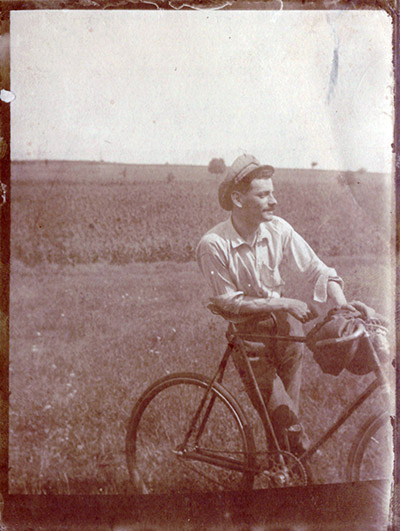
Isak Abraham, date and location unknown.
Collection of Iris Eldar Nir
1910s
Like his brothers, Isak left Ruschuk to further his career. Unlike them, however, he didn't go to Constantinople, but instead came to Varna, the third largest city in Bulgaria.
There, Isak was Director of the Varna branch of Crédit Ghirdap.
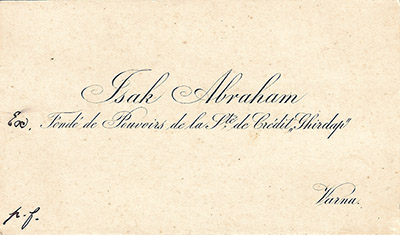
Isaac Abraham, (Ex) Fondé de Pouvoirs de la Société de Crédit Ghirdap, Varna
"Fondé de Pouvoirs" can be translated as "Authorized Officer". In financial companies, this applies to members of management who have been given the mandate to negotiate and conclude major transactions. Other documents refer to Isak as "Directeur de la Société de Crédit Ghirdhap, Varna."
The earliest mentions of Isak as Director of the Varna bank date from 1910, when he was just twenty-seven years old, although he might have been in this position even earlier. How did Isak become the director of a bank at such a young age? Maybe family connections with members of the Ghirdap board in Ruschuk helped him land this position. In any case, the story of Ghirdap, from its rise to its collpase, may have played an important role in Isak's life.
Crédit Ghirdap, the first privately owned Bulgarian Bank had been founded in 1881 in Ruschuk. In 1898, its board of managers consisted of twelve of Ruse's wealthiest and most eminent people. In the autumn of 1902, Ghirdap opened its first branch offices in Varna, in Dobrich and in Constantinople.
The bank had close ties to the Popular Liberal Party of Stefan Stambolov, one of the "Founders of Modern Bulgaria" and its Prime Minister. Girdap's heyday was during the Balkan Wars and World War I (1912-1918), when it became the leading financial group in the kingdom and remained close to the government. After World War I however, Girdap was deprived of its government protections, as it had no links to the new agrarian government of Aleksandar Stamboliyski. In 1919, its manager was imprisoned for eight months, and the bank's funds were sealed. In 1922, the Bulgarian National Bank closed Girdap's account, causing 38 million leva of deposits in Girdap to be withdrawn by 1923. Girdap declared bankruptcy in February 1925 and its managers were arrested.
Although precise details are lacking, all traces of Isak in the 1920s place him first in Vienna, then later in Berlin, so it is possible that, having first moved to Varna to join Ghirdap, he then left Bulgaria after the collapse of the bank.
Zionist Activities
Isak's name appears, as Isaac Avramoff, in the publication "Zionist Work in Palestine" (1911) (London : Pub. on behalf of the Zionist Central Office by T. F. Unwin). He is listed as the representative of the Jewish National Fund Agency in Bulgaria:
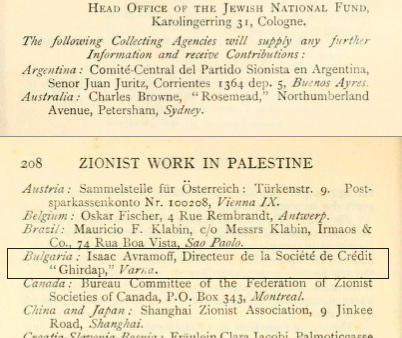
Isaac Avramoff, Directeur de la Société de Crédit Ghirdap, Varna
Isak's name also appears, again as Isak Avramoff, in three issues—#6 (February 10, 1911), #14 (April 7, 1911), #29 (July 19, 1912)—of Die Welt, the official organ of the Zionist Organisation, listing donations collected.
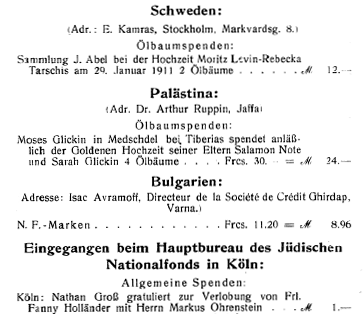
Die Welt, 1911: Isaac Avramoff
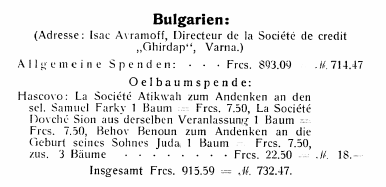
Die Welt, 1912: Isaac Avramoff
Abramov is the Bulgarian translation of Abraham (or rather, Abram), as confirmed by this envelope.
If, as I assume, "Isak Abraham, Ex Fondé de Pouvoirs de la Société de Crédit Ghirdap" and "Isaac Avramoff, Directeur de la Societe de Crédit Ghirdap, Varna" were one and the same person, these listings provide some interesting information.
First, they indicate that Isak was succesful at a relatively young age - he would have been the head of a branch of a bank when only 27 or 28 years old.
They also show that, like his brothers Haim and Moritz, he was involved in Zionist activities - apparently in charge of fundraising for Bulgaria.
Argentina?
There is no information on Isak's whereabouts between 1912 and 1924. An immigration manifest to Argentina dated 1916 raises the intriguing possibility that he might have moved to the New World, at least for a few years. While researching his younger brother's Mony immigration to Buenos Aires, I wondered if he had relatives there, and found an entry for someone who closely matches Isak's identity:
| Manifest / Immigration Registry | |||||||||
|---|---|---|---|---|---|---|---|---|---|
| Last Name | First Name | Age | Civil Status | Nationality | Place of Birth | Occupation | Arrival Date | Ship | Port |
| Abraham | Isaac | 33 | C | Rushtshuk | Merchant | 1916/11/14 | Malte | Santos | |
While this could simply be a coincidence, one has to consider the odds of there having been two merchants named Isak/Isaac Abraham, born in 1883 in Ruschuk. According to Wikipedia, there were 1,943 Jews in Ruschuk in 1883.
There are no other documents have been found so far that would help confirm that "Isaac" and "Isak" are the same person, but if they are indeed the same person, this might help explain why his brother Mony chose Argentina as his new home in 1925.
On the other hand, Isaac is listed as being married ("C" = Casado = Married) on the manifest. I am not aware of Isak Abraham having ever been married, so this could, after all, be a different person.
1920s-1930s
In 1924, Isak sent a photo from Vienna to his brother—whom he now called "Moise"—with wishes for the Jewish New Year. It is unclear whether he was living in Vienna at the time or merely passing through.
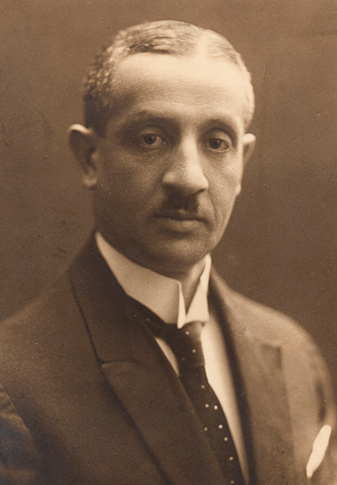
Isak Abraham, Vienna, 1924
This 1928 photo was taken in a photo studio in Bad Ischl, a spa town in Austria.
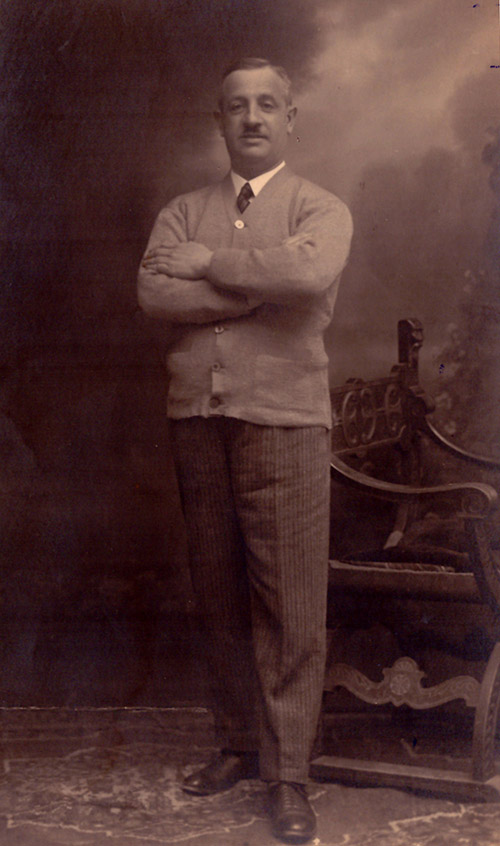
Isak Abraham, September 30, 1928
Bad Ischl, Austria.
Collection of Iris Eldar Nir
A draft of a Power of Attorney drawn in the 1920s to allow an unnamed party to sign a mortgage agreement between Isak ("Abramov") and his maternal grandmother Rebecca Yaakov for her half of a house in Ruschuk indicates that Isak lived in Berlin when this document was created.

Power of Attorney for mortgage, 1920s
"I, Rebecca Isaac Solomon Jakob, from the city of Ruschuk, now living in Vienna, 11 Prater Straße # 34, floor IV, auhtorize ( no name ) from ( no city name )
- to conclude a mortgage agreement and to mortgage to Isaac M. Avramov from the city of Ruschuk, now living in the city of Berlin, 1 Tatsenuĭnŭ street (Таценуинъ = Tatzenwin, possibly Tatzenwinkel street ? in the Reinickendorf district), my half of the house in the city of Ruschuk, which I have 27 Evreiska street ("Jewish street"), now [called] David Street, plot 69 with neighbors: Merdohai Nesimov, heir to Jewish street, now David street.
- to appear before all persons, authorities and institutions and the Notary in the Kingdom of Bulgaria to take out the mortgage and sign all the papers on the case, and this mortgage made for 140,000 Leva equal to 5200 Swiss Francs with 10% annual interest for 3 years from interest will be paid every six months."(Note that the wording and the exact addresses are not completely clear (Google translate).
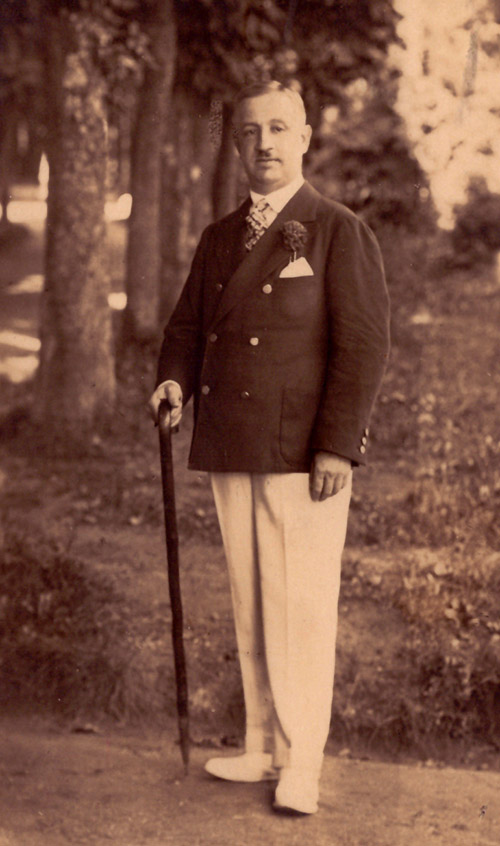
Isak Abraham - August 29, 1930
Collection of Iris Eldar Nir
In January 1931, Isak sent a photo to his brother, whom he now called "Moritz". His address was Kaiser allee 66, Berlin-Friedenau.
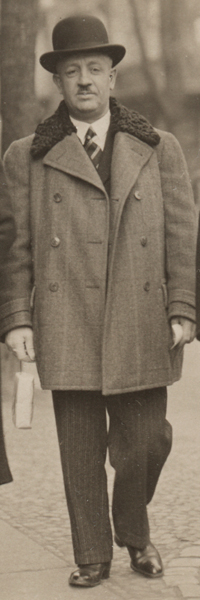
Isak Abraham - Berlin - 1931
Isak Abraham never married and left no descendants. He died on December 11, 1931, at the age of 48. His occupation was listed as "Kaufmann" (businessman/trader/merchant). His last home was Berlin-Friedenau, Kaiser allee 66 (although in a document dated 1956, his last address was given as Berlin, Wittenbergerplatz (probably Wittenbergplatz), "in a well-known pension".
Isaak was buried in the Weissensee Jewish Cemetery in Berlin.
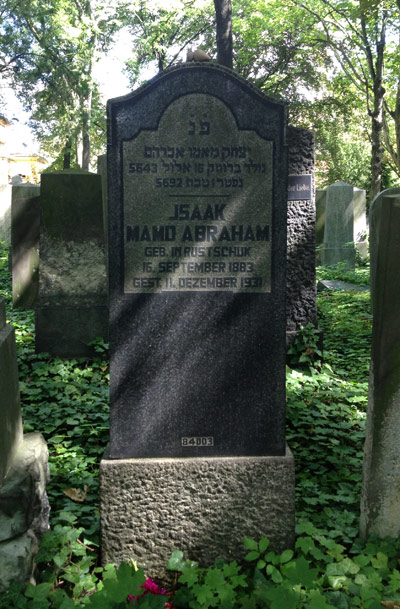
Isak Mamo Abraham's tombstone, Weissensee cemetery, Berlin.
Isaak's Will
The beneficiaries of Isaak's will were two of his brothers - Chaim (Haim) and Mony - and his two nephews - my father Uriel, and his brother Gideon (Gisy). Left out from his will was his third brother, my grandfather Moritz. It's not clear why he decided to make this exception, and whether this indicates a possible falling out between Isaak and Moritz.
At the time of his death, Isaak owned or co-owned seven rental properties in Berlin. It's not clear what happened to his estate. However, what happened to one of the properties would trigger a lengthy lawsuit initiated by my grandmother Ronya after the war.
According to documents related to the case, the property was supposedly bought in 1934 by a person also named Isaak Abraham. After his death in 1938, the property was then sold for a fraction of its value due to the Aryanisation laws. According to Ronya, it was difficult to believe in such a bizarre coincidence, and she argued that it had to be a hoax since, according to her, Jews couldn't buy real estate in 1934, but were instead pressured to sell what they owned, and at a steep discount. (The argument that Jews were not allowed to buy propery in 1934 was actually incorrect, as there were no such laws at the time.) After years of proceedings, the lawsuit ended unsuccessfully in 1957 and Ronya lost the case.
- Very Special Thanks:
- Antonia Belt, for visiting the Weissenssee cemetery on my behalf and photographing Isaak's tombstone.
- Links and References
- Zionist work in Palestine, Israel Cohen, London : Pub. on behalf of the Zionist Central Office by T. F. Unwin (1911) archive.org